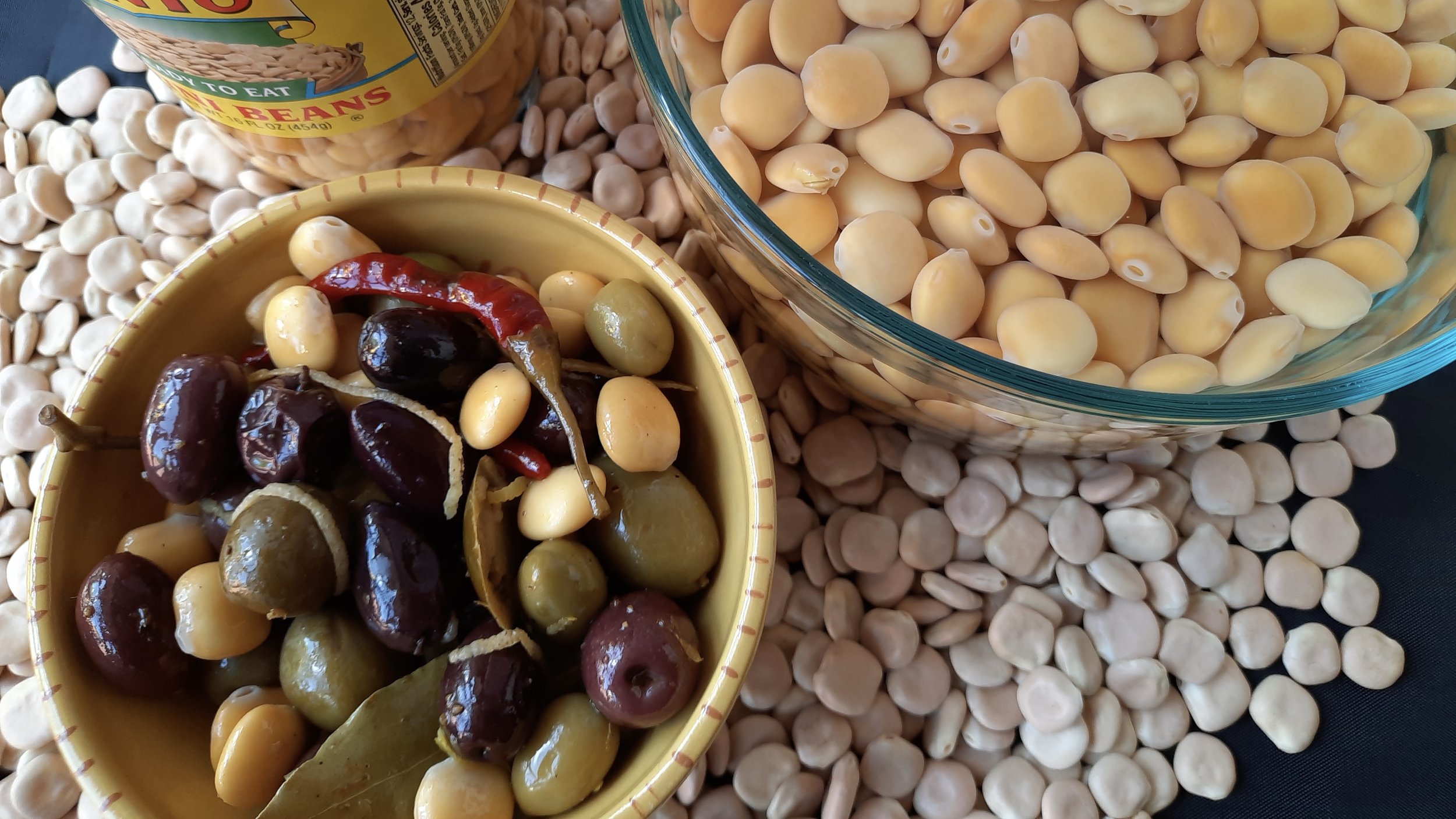THE LUPINI BEAN
Really cool recipe for Marinated Lupini Beans and Whole Olives follows the, well, cool infos on the Lupini Bean.
When you’re up in our magnificent mountains—biking, say, or hiking, camping, driving—you’ll see hundreds, if not thousands, of beautiful lupines (well, at least through late spring into autum). This member of the pea family (the Fabaceae, also Leguminosae) sports tall spikes of flowers in a stunning depth of the colors mauve, blue, pink, even white.
As its Latin family names suggest, lupines have long been raised as food, like the fava bean and other legumes. Lupines are among the most ancient of food-bearing plants on earth.
We Americans (save for Italian-Americans) aren’t that familiar with the “lupini bean” that, when dried, is an ivory-colored legume resembling a small dried lima bean. But for centuries, the peoples of both the Middle East and the Mediterranean Basin have cooked and eaten lupini beans. Italian-Americans, especially, snack on them in the same way that all Americans eat steamed edamame as a starter in Asian restaurants.
“I make them [for sale, cooked] at Easter and Christmas,” says Gino Scarafiotti, owner of Belfiore’s Italian Sausage in Wheat Ridge. “I remember popping them out of their skins at my sister.” Scarafiotti’s shop sells a t-shirt that illustrates just such a way “how to eat the lupini bean.”
But you cannot eat the lupine’s legume raw; it is overpoweringly bitter, even acrid, and toxic as such. Dried lupini must be soaked for two days, cooked for (at least) two hours and soaked in a refrigerated, light brine for upwards of two weeks—all in order to leach out that bitterness and danger. That is why the overwhelming amount of lupini beans are purchased in already-cooked and jarred form, the producer having done all the soaking, boiling and brining for you. (I have been soaking and refreshing the brine for my batch for a week now and they remain still acrid.)
The ancient Egyptians and Phoenicians, both history’s first large-scale makers of beer, used lupini as a bittering agent in the brewing of their suds centuries before hop flowers were found to provide the same service.
Despite its need for laborious preparation, the lupini is much sought-after for its dietary advantages. Its flavors are fairly neutral, though slightly nutty, therefore providing a convenient background for other flavors when eaten. It is commonly marinated, along with other foods such as olives and peppers, or topped with any manner of ingredient such as lemon juice, olive oil, herbs, flavorful seeds and the like.
Gluten-averse folk use its flour made into bread, pasta and crackers. Its protein percentage is among the highest of any legume, sometimes approaching 50 percent. Its list of vitamins, minerals and amino acids is ridiculously long, as if you read off the labels of nearly every jar for sale at a common supermarket’s vitamins and minerals section. And, especially if you eat its skin (instead of just popping the bean at your sibling), its fiber is also among the highest of any edible plant.
However, some nutritionists suggest that those with nut allergies avoid eating lupini.
You may purchase lupini beans at these area Colorado-are Italian-centric markets and grocers:
Jarred only:
Belfiore’s Italian Sausage, 5820 W. 38th Ave., Wheat Ridge (303) 455-4653, belfioreitalian.com (Also, proprietor-prepared lupini at Easter and Christmas.)
Vinnola’s Italian Market, 7750 W. 38th Ave., Wheat Ridge (303)421-3955, vinnolasitalianmarket.com
Both jarred and uncooked, dried:
Carmine Lonardo’s Italian, 7585 W. Florida Ave., Lakewood (303) 985-3555, carminelonardosmeatmarket.com
Spinelli’s Market, 4621 E. 23rd Ave., Denver (303) 329-8143, spinellismarket.com
Valente’s Deli, Bakery & Italian Market, 7250 Meade St., Westminster (303) 429-0590, valentesdeli.com
RECIPE: Marinated Lupini Beans and Whole Olives
Makes 2 cups. Use a mix of whole green, black, brown, and purple olives from various regions of the world.
Ingredients
1 cup whole olives
1 cup lupini beans, cooked or jarred, rinsed and drained
Red or green hot or mild peppers, whole, to taste
1/4 cup fruity extra virgin olive oil
2 teaspoons unflavored rice vinegar or lemon juice
1/2 teaspoon cracked black pepper
3 small bay leaves, left whole
2-3 garlic cloves, peeled and very thinly sliced
1 teaspoon herbes de Provence, lightly crushed
1 tablespoon giardiniera in oil
Rind of 1/2 lemon, stripped and sliced into very thin strands
Directions
Combine all ingredients but the olives, beans and whole peppers in a small saucepan and heat, stirring, until just warmed through. In a large bowl, add to the olives, beans and peppers and mix together well.
Place in a nonreactive bowl or jar, cover, and refrigerate for at least 3 hours or overnight. To serve, bring to room temperature, stirring back in the flavorings. The mixture will keep, in the refrigerator, for a month or more.
